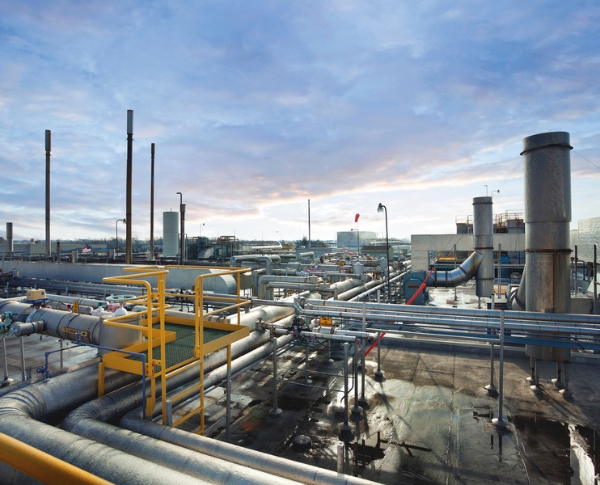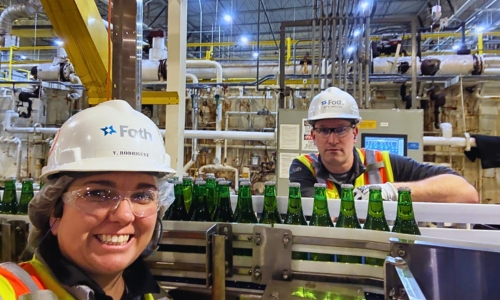
As companies explore long-term strategies to strengthen manufacturing and supply chain resilience, reshoring has emerged as not just a viable option, but a critical one. To gain deeper insight into the process and its implications, we spoke with lead process engineers at Foth who shared their expertise on what it takes to successfully bring manufacturing operations back home.
Q: What is reshoring, and why are companies considering it?
Answer: Reshoring is the process of relocating manufacturing operations from an international location to a company’s original country. It requires intricate logistical planning and a clear understanding of both current operations and future goals. There are several benefits to reshoring or relocating operations, including cost reduction, quality improvements, enhanced safety, supply chain reliability, and reduced lead times.
Q: How is reshoring different from relocating operations within the same country?
Answer: There are key differences. Domestic relocation still involves variations in labor availability, skill levels, and costs. Material and utility availability and pricing also play a big role in the decision-making process.
Q: What are some common pitfalls of reshoring?
Answer: One of the biggest challenges is achieving alignment among stakeholders. It’s easy to underestimate how long that takes. Teams should avoid overanalyzing options to maintain momentum.
Another issue is “paralysis by analysis”—getting stuck in decision-making. That’s why it’s crucial to have a dedicated decision-maker that is involved full-time to guide choices. Additionally, cost and labor impacts must be tracked in real time to inform smart decisions.
Q: What types of facilities benefit the most from reshoring?
Answer: Facilities with high labor costs that can be automated using off-the-shelf or custom machines benefit most from reshoring. These operations can reduce labor headcount through automation, making domestic production more cost-effective. The ability to streamline processes while maintaining quality makes reshoring a smart move for these types of facilities.
Q: How long does the reshoring process take?
Answer: Here’s a breakdown of the phases to effectively plan and execute engineering, construction, and commissioning of a relocated manufacturing facility:
- Due Diligence (3–6 months): Assess feasibility, align stakeholders, and define strategic goals
- Assemble internal and external project team representative of all stakeholders
- Understand and document the operations at the offshore facility
- Understand and document the Cost of Goods Sold (COGS) at the offshore facility
- Understand supply chain and distribution logistics at the offshore facility
- Creating the right sets of documents is key to quickly compare offshore vs reshored costs
- Stage 1 – Conceptual Planning (6–8 months): The most critical step in the process where duration is most uncertain, this is when we develop facility layouts, estimate capital costs, select a site, and calculate early ROI. Ends with a “go/no-go” decision
- Conduct brainstorming sessions to re-imagine what the new facility might look like
- Create a first pass at what the reshored factory might look like. It will include:
- Suggested layout with a Rough Order of Magnitude CAPEX cost (AACE Class 1).
- Operating supply chain and logistics plan, an operating labor plan that feeds into an OPEX cost/COGS
- Preliminary site selections that meet minimum requirements for distribution and utilities
- Researched and itemized government financial incentives that can be applied to the ROI calculations
- OPEX and COGS of the “first pass” will be compared to the offshore facility. ROI calculations are run with the CAPEX from above.
- Then an iterative do-loop process starts where the internal team examines OPEX vs CAPEX and works with the consultant engineering team to generate options that adjust factory design and site selection to optimize the OPEX vs CAPEX balance to achieve ROI
- During stage 1, the client’s internal team manages the political environment and conducts negotiations
- It is most important at the end of stage 1 that a site has been selected
- Major project deliverables include:
- Preliminary process and utility flow diagrams with capacity usage
- List of major equipment and cost estimate
- Preliminary power sizing, layout, and logistics plan for incoming material and outgoing product
- Site selection
- AACE Class 5 Capital Estimate
- Preliminary schedule
- ROI calculation
- The end of this effort is a go/no go waypoint
- If a “go,” funding for site purchase and stage 2 engineering should be appropriated
- Stage 2 – Preliminary Engineering (4–6 months): Refine scope and cost estimates, and secure funding
- Major Engineering Deliverables:
- Preliminary building design identifying processing areas, warehousing, employee welfare, incoming and outgoing material, etc.
- Detailed process and instrumentation diagrams are developed for the site
- Process and utilities equipment list make/model are finalized with firm costs
- Definition of power and controls infrastructure
- AACE Class 4 Capital Estimate
- Updated Schedule
- Revised ROI Calculation
- The end of stage 2 delivers an appropriation grade estimate used to secure complete project funding
- Once funded, the project team will look to buy all long lead equipment
- Major Engineering Deliverables:
- Stage 3 – Final Engineering & Procurement (4–6 months): Finalize designs, select contractors, and procure equipment
- Major engineering deliverables:
- Final engineering creating construction drawings
- Contractor bidding, shakeout, selection, and award
- Controls programming
- Purchase of remaining equipment
- Capital Estimate refined to AACE Class 3 or 2 level depending on level of engineering needed vs. timeline available
- Major engineering deliverables:
- Construction (8–12 months): This step can vary greatly depending on the project size and complexity but generally entails coordinating with a multitude of contractors and suppliers to build the facility – inside and out.
- Commissioning (2–6 months): This step varies with equipment and controls complexity but generally entails testing systems, training staff, and preparing for full-scale operations.
Q: Who would benefit most from reshoring?
Answer: High-volume operations that have a large labor cost component and can be automated with use of off-the-shelf machines that already exist benefit the most. Next in line are facilities that require Serial 1 Automation to reduce labor and create additional efficiencies.
Q: Speaking of labor, how does that factor into reshoring success?
Answer: An educated, available labor pool is a major consideration. Reshoring typically involves fewer workers than offshore operations, thanks to automation. But that means you need more skilled labor to operate and maintain the equipment. The higher cost of skilled labor is offset by the reduced headcount, and that should be factored into ROI calculations.
Q: How do you ensure quality and compliance during the reshoring process?
Answer: Quality and compliance issues often come from poor communication and unclear ownership. A single, experienced engineering partner reduces risk and ensures alignment. One team with full visibility is best positioned to deliver consistent results.
Final Thoughts:
Answer: Reshoring is a complex, multi-year journey that requires strategic planning, cross-functional collaboration, and a strong grasp of both technical and financial elements. With the right approach, it can lead to more resilient, efficient, and competitive manufacturing operations.
Learn more about Foth’s services for reshoring and relocating manufacturing facilities.
Markets: Consumer Products, Food and Beverage, Manufacturing and Industrial Products, Pulp and Paper, Waterfront and Marine
Services: Design-Build / Alternative Project Delivery, Manufacturing Reshoring, Strategic Consulting and Planning



